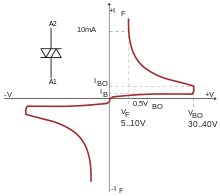Diac
The diac is a diode and is also called a bidirectional diode . The path between the connections only becomes conductive when the voltage across them exceeds the breakdown voltage . In contrast to the similar but outdated four-layer diode , it behaves approximately symmetrically in both quadrants of the current-voltage characteristic.
The term diac is an acronym that stands for English Diode for Alternating Current (dt. Diode for alternating current ). There are also diacs under trade names such as SIDAC , English Silicon Diode for Alternating Current, which, depending on the type, have higher ignition voltages.
construction
Diacs are multilayer semiconductors . There are versions with pnp junctions (three-layer diode) and pnpnp junctions (five-layer diode). In terms of structure, they correspond to an anti-parallel connection of two thyristors , as shown in the equivalent circuit opposite, similar to a triac . In contrast to this, the control connection is missing.
The two connections are called anode 1 and anode 2, because the symmetrical structure means that no polarity can be specified.
A precursor component that is no longer manufactured is the Shockley diode (a four-layer diode).
function
Due to its bidirectional structure, the diac can also switch AC voltages. As soon as the voltage at the connections (A1 and A2) exceeds a certain threshold voltage, it switches through and the pn paths become conductive. This type of ignition , which is also possible with triacs (but should be avoided with these), is also called overhead ignition .
Only when the current flowing through the diac falls below a certain value, the holding current, does the resistance rise rapidly again. This process is also known as deleting the diac.
Due to deviations in the crystal lattice and other manufacturing tolerances, the two switching voltages in the positive and negative directions are not exactly the same. The difference is called the symmetry deviation.
Diacs have a similar function to spark gaps , which also become low-resistance when a certain ignition voltage is reached. However, they differ in the relevant voltage ranges. While Diacs are used for low voltages of up to a few 100 V, spark gaps in the high voltage area such as the Marx generator are used up to several 100 kV.
Characteristic values
The following values are only guidelines that give an idea of the approximate orders of magnitude.
- Ignition voltage, referred to in the diagram as V BO (from English: breakover = breakthrough): 20 ... 200 V (typical value 35 V with strong sample variation )
- Current shortly before the breakdown I BO , typically 10 µA
- Holding current: 5… 50 mA, shown in the diagram as 10 mA as an example.
- Symmetry deviation : ± 4 V
- Resistance in the high-ohm state: a few MΩ
- Resistance in the low-ohm state: a few Ω
- Maximum power loss approx. 300 mW
use
Diacs are mainly used in triac ignition circuits to generate an ignition pulse from a gradually increasing voltage. In practice they are z. B. used in the control electronics of energy-saving lamps or in dimmers . In phase angle controls with vertical control, diacs serve as switches for an adjustable threshold. In the Royer converters of energy-saving lamps, they should provide an impulse to safely start the converter, since Royer converters have oscillation difficulties if their supply voltage increases too slowly when they are switched on.
Since the current-voltage characteristic is very similar to that of the glow lamp (this only has a higher operating voltage), a breakover oscillator can be implemented with a diac, similar to that of the diac . This application can be used for analog-digital conversion by adding a direct current to be measured to a capacitor, which emits a pulse via the diac when the ignition voltage is reached. The pulse repetition frequency is proportional to the current.
Type overview
There are only a few common diac types, so an overview of types can be given here without any effort.
- BR100-03: DO-35 housing ; Manufacturer Philips / NXP
- DB3, DB3TG, DB4, D30, ER900: DO-35 housing; Manufacturer ST
- DB3A, DB3B: DO-35 housing; Manufacturer Taitron
- SMDB3: SOT-23 package; Manufacturer ST
- NTE6407, NTE6408: DO-35 housing; Manufacturer NTE
- NTE6411, NTE6412: DO-35 housing; Manufacturer NTE
- TMMDB3, TMMDB3TG: Minimelf Housing; Manufacturer ST
Web links
Individual evidence
- ↑ Data sheet Kxxx1g series , SIDAC, (PDF, English; 722 kB)
- ↑ http://www.elektroniktutor.de/bauteile/diac.html
- ↑ http://www.farnell.com/datasheets/1689752.pdf Data sheet SMDB3 (PDF, engl.)
- ^ Tilting oscillator with diac. Retrieved September 19, 2018 .
- ↑ Current measurement in a high voltage source for insulation testing


